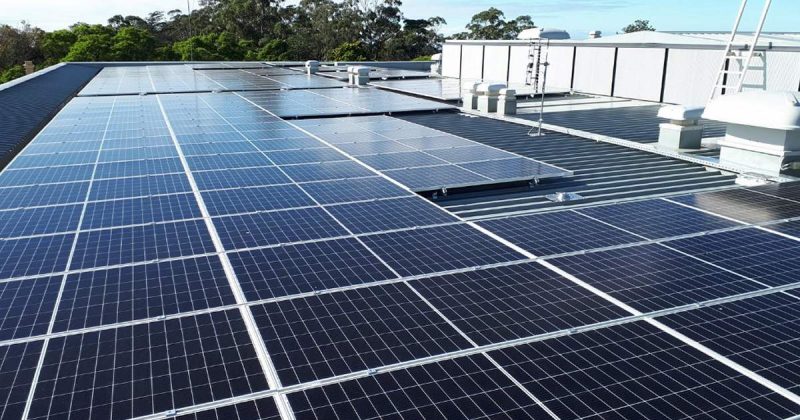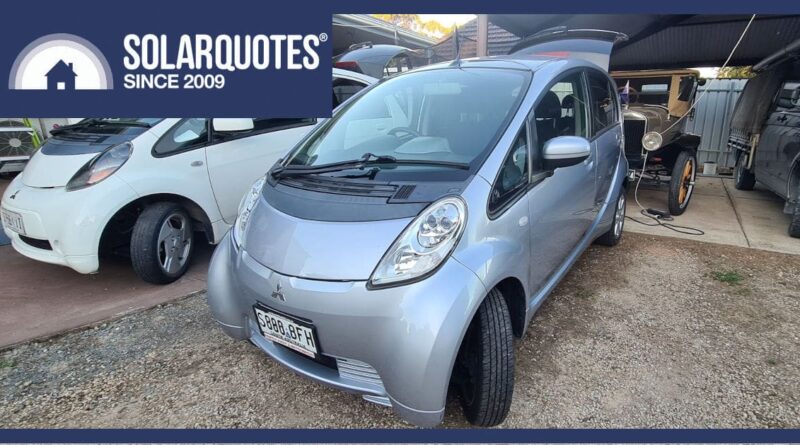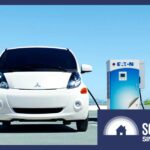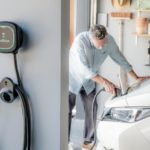I Just Bought The Cheapest Electric Car In Australia… Again
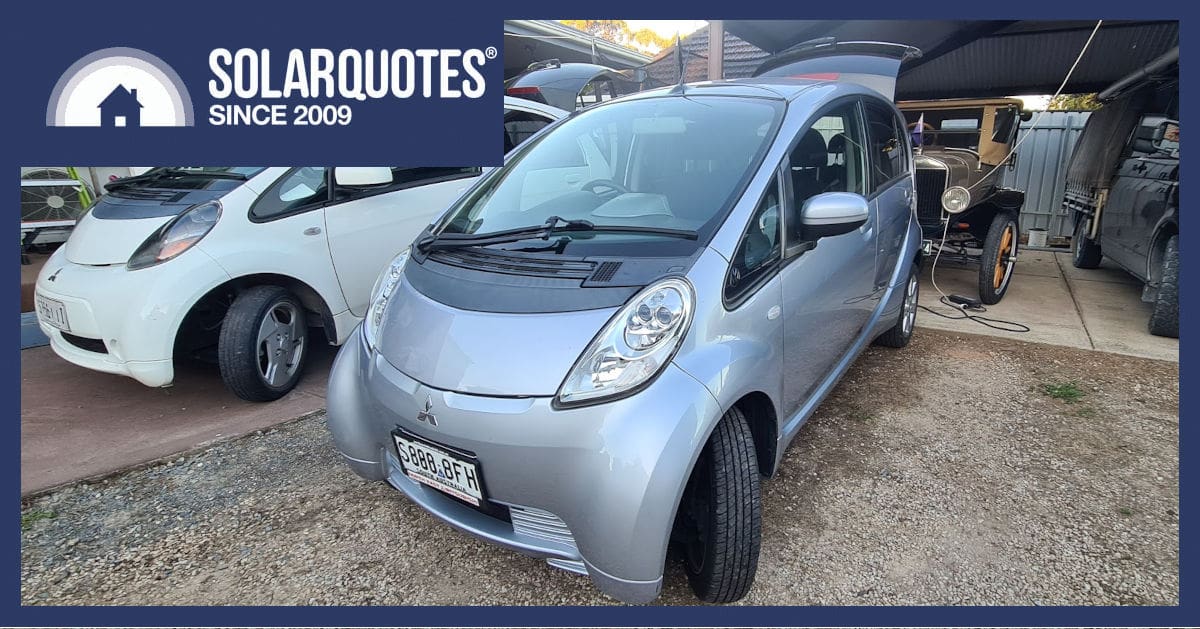
I can’t quite believe it’s been over a year since I penned an article about buying my first EV.
Despite my Mitsubishi i-MiEV being the cheapest in the country at the time, dropping $17,000 on an 11-year-old car was a little impulsive. However, with just 25,000km on the clock, it was about the newest car I’d ever owned. And so cute I’ve even named her: Irene.
At the time, my original article broke a couple of SolarQuotes website records, or so I’m told, with more than 40,000 people following along for the ride. I guess that proves two things, Australians are cheap; and just as interested in electric cars as I am. Since then, sales records for new EVs have continued to tumble.
So anyway I have a confession to make. I’ve bought yet another i-MiEV and my wife is already suspicious about the cover-story that my 203cm-tall dentist owns it.
For those asking why anyone would need two EVs that will reliably make 75km on a single charge… Well, for only $4,000, how could I not?
There’s more details below, but first, I’ve been meaning to write a follow-up on Irene, so here’s a few notes on my 6000+ kilometres travelled by kei car.
What’s Great About Owning An EV?
EVs Get You From A To B
The thing is, these little cars do exactly what most people need. Irene is a shopping trolley that sails through roundabouts, slips through gaps into turning lanes, and parks anywhere easily. According to the kids, the school run is a riot.
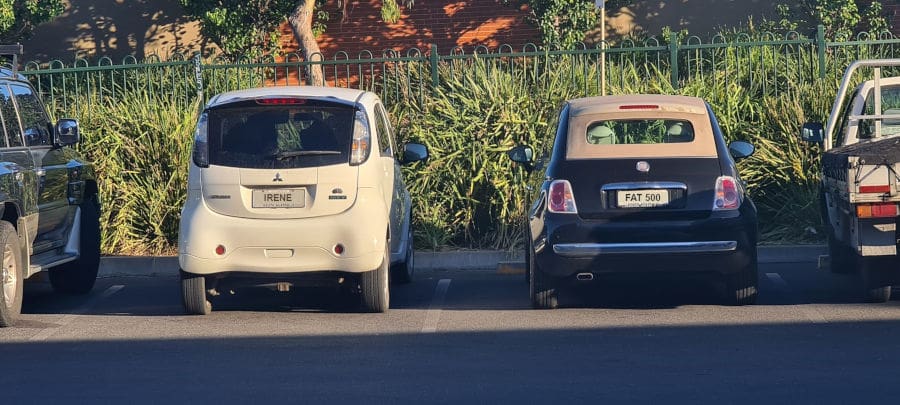
The Fiat 500 is pretty obese compared to it’s 1960s roots, but it’s still easy to park
At my local primary school, all the odious oil burners crawl up the access lane, stop for the zebra crossing, turn 180° (many can’t even manage that without backing & filling) then form a stuttering queue back to the road.
I stop near the entry/exit, because Irene is so small I can make a U-turn from the parallel parking bay and head straight back out.
Teachers and parents are so concerned about air quality at the school gate that they’re mandating people not sit in their cars with the engine idling. Want to keep your aircon running? With an EV it’s no issue.
The average new car in Europe has grown half a centimetre wider every year since 2001.
— Quite Interesting (@qikipedia) February 9, 2024
Supremely Low-Cost Motoring
For the first 1,340 kilometres, 196.3kWh and 19-or-so charging sessions, I kept a very careful record of how much energy Irene sipped.
I’m not quite dull enough to have kept that up for an entire year, but I think my mileage figures are relatively bad because I’m using air conditioning and doing highway speeds at times. I’ll have to check it again.
Even so, my consumption at 14.64kWh per 100km, using $0.45/kWh for peak-rate electricity. That’s $6.50/100km.
If we value solar electricity from my roof at $0.08 per kWh, the cost of motoring plunges to $1.17/100km.
Many people don’t readily comprehend fuel economy unless you’re speaking in miles-per-gallon. So to put it another way, $6.50 would buy 3.25 litres of diesel, enough to drive my VW Transporter 27km, maybe.
At $2 per litre for diesel, $1.17 will get me a little over an imperial pint. Or, 4.8km, which won’t even get me to the pub (where liquid fuels are five times more expensive).
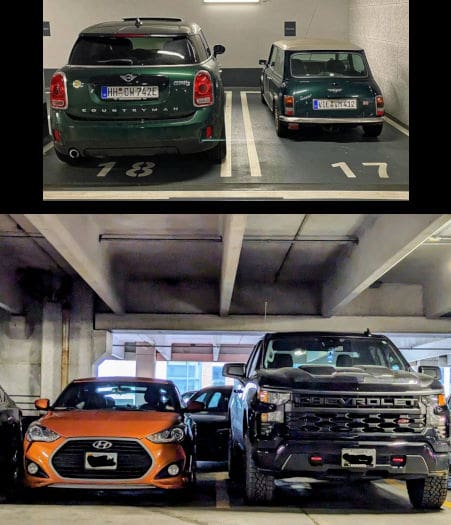
I still miss my Mini, but the driver in that Chev would never have even seen it.
What About Energy Consumption?
- 6-10kWh/100km = very modest consumption.
- 15kWh/100km = average EV consumption at highway speed. 1
- 22kWh/100km = heavy consumption from a converted 1960s Land Rover, for example.
- 23kWh/100km = a Tesla Model 3 towing a caravan 17,250km around Australia for 40 days.
Miniscule Costs For Maintenance
Servicing costs for Irene over the last year have been zero, with the exception of water for the screen washer and pumping up the tyres.
The front tyres are worn now, and I was prepared for some extortionate price or lead time because of their unusual size.
But it turns out the skinny little 145-50/15″ tyres aren’t expensive or rare. I’m looking at $300 a pair for top-quality, factory-fit Dunlops, or half that for cheerful versions.
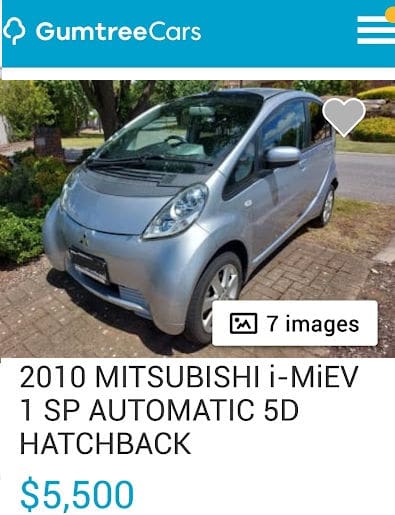
I didn’t ask how many actual inquiries there had been, but the nice lady took my first offer of $4,000. Dammit.
How Fast Does It Charge?
With the troglodytes and nervous nellies clutching their pearls about sub-600km range, I expect questions, including as to how fast it charges.
On a rapid DC public charger it’s about 25 minutes. I’m told that CHAdeMO is both the name of the fast charging plug and a play on words — Japanese for the ‘cup of tea’ you can drink while you wait.
At home it’ll charge at 12 to 14 kilometres per hour, when parked of course.
And yes, you read that right. A standard wall charger puts out 2kW, so that means I can pick up roughly 13.66km of range for each hour spent plugged in. We need a new three letter acronym, range per hour, kR/h perhaps?
Why I’ve Bought Another One
Honestly, $4,000 is the main reason I bought it. For that sum, I was expecting something to be fundamentally flawed, but the tyres are great, the air conditioning works, and it’s even got brand-new monogrammed floor mats. Unlike a converted classic Land Rover, it’s got ABS, stability control, electric windows, airbags and a heated seat; for about $96,000 less.
Like other cult classics, the iMiev is just endearing. They’re often low mileage because they’re not designed for long distances, and people just seem to look after them. We need more of that basic conservation. As a species we can’t expect to have nice things if we keep consuming at exponential rates.
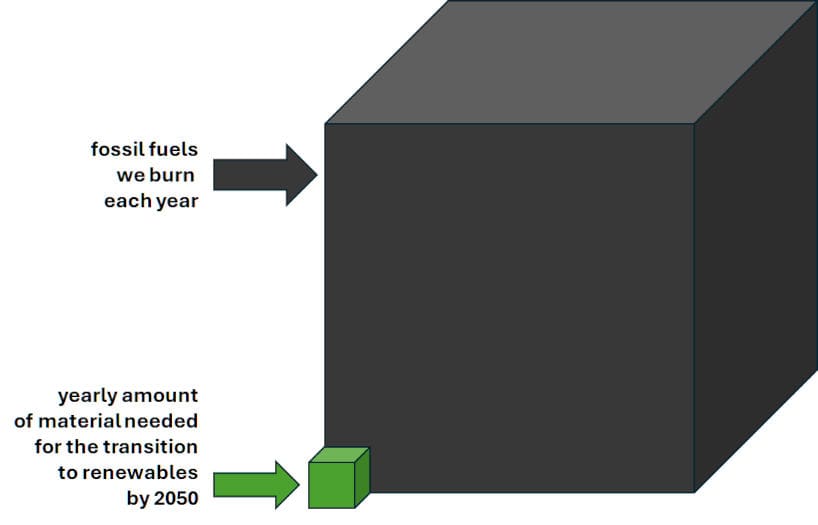
This mind-boggling graphic puts things into perspective. Image credit: twitter.com/AukeHoekstra.
Why So Cheap?
In a word, hail. When you get close enough the roof looks like a golf ball (we have named this car Greg the Golf Ball… a white shark he is not).
So far I’ve only spent a couple of days driving around and haven’t had an opportunity to run all the tests I’d like.
However, like many EVs, the iMiev can be interrogated with an OBD2 connection and an app on your phone. So far, the onboard systems tell me the battery has a ‘state of health’ of between 57% and 61% — worn but certainly not a disaster for a 13.5-year-old battery.
At 63,000km you would expect a petrol-powered car to be in fine fettle. But I know first-hand as an engine machinist, it only takes one good episode of overheating to blow a gasket, rendering a cylinder head soft and useless. At 10 or 15 years old, cooling system corrosion can ruin an engine, exhaust or fuel tank too.
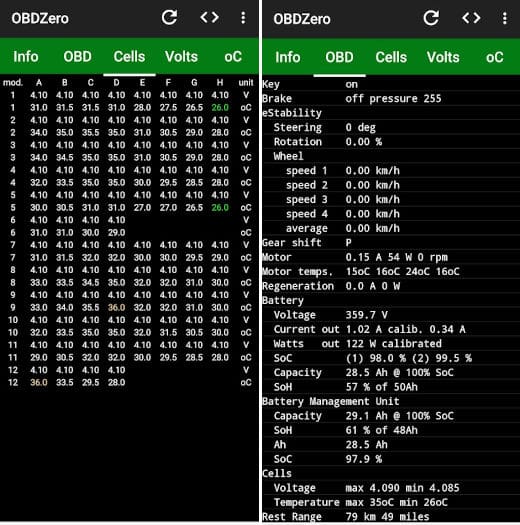
There’s oodles of information for nerds if you buy a cheap Bluetooth diagnostic module.
Won’t It Soon Be Worthless?
Not at all. As a work experience kid, I remember helping recondition the engine in a VK Commodore at just 120,000km. It was probably six or seven years old, but burning oil and worn out.
The last of Holden’s six-cylinder engines were rubbish, so working to better tolerances than the factory, we made it better than new, but I assure you it would never go twice as fast or use half the fuel.
While some dismiss EVs as a fad that will end up a liability or in landfill, we’re already seeing a secondary market emerging for new, improved batteries. For around $16,000, OZ Electric Vehicles will repack your iMiev and give it double the original range.
Your car becomes better than new — doubly so — for less than a third of the original purchase price.
Better still, OZ repurposes the old cells for less demanding applications such as off-grid house batteries.
Cheap EVs Are Out There
A quick search on Valentine’s Day produced this crop. I couldn’t believe there were so many iMiEVs available. In fact, these listings represent more than 2% of the whole Australian fleet. Come to think of it, I own 1% of them myself.
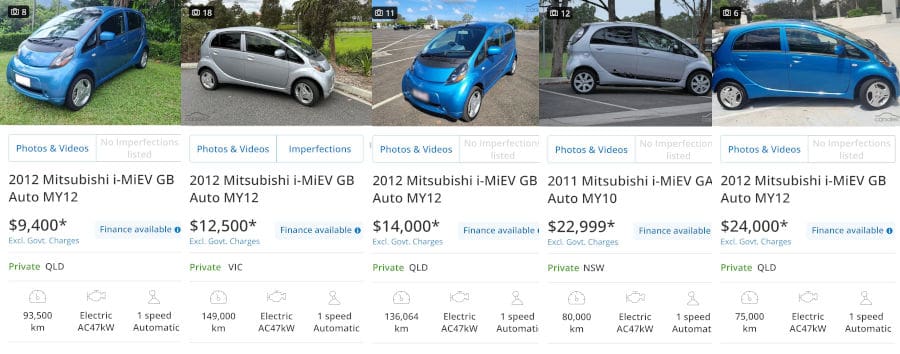
They’re available in black, white and red too. A couple of these even have new batteries fitted already.
I’ve Always Been A Small Car Advocate
Car collecting is a curse and a joy. I’ve lent Irene to my mum now, so it’s definitely joy that I’m spreading.
Fun fact: Kei cars are incredibly popular. Despite reduced tax incentives, they have often represented 30% to 40% of the Japanese domestic car market (where street parking is a regulated privilege). They’re narrow, upright, often boxy little vans, utes and sedans, normally powered with a 660cc two- or three-cylinder engine with an industry self-imposed power limit of 47kW.
In Australia, they’re just as useful, just as economical, and wildly underrated. No, you won’t get 800km on one charge, but the average commute in Australia is 15.6km. Forget about Ned Kelly and the bush, most Australians are in fact Ned Flanders in the suburbs — Greg or Irene will get you to the beach and back, with a school run and grocery run enroute.
It’s Not All Beer And Skittles
I would be lying if I said EV ownership was all fun and games. Next week I’ll put some context around what’s happening in this image. Stay tuned.
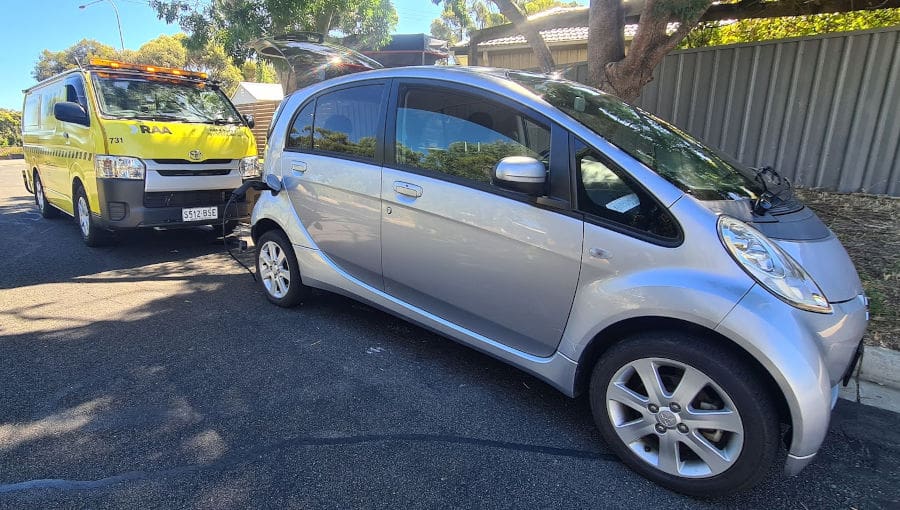
Original Source: https://www.solarquotes.com.au/blog/cheapest-electric-car-australia-imiev/

